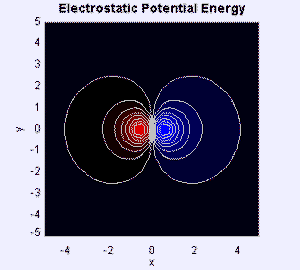

[The dipole electrostatic potential.]
We study scalar and vector fields in 2D and learn how to solve Laplace's equation using the relaxation method.
A quantity, such as temperature, that has a numerical value at every point in space is a scalar field. The Dipole Field Model displays the potential produced by an electrostatic dipole. The potential field's values are computed on a grid defined as the potential[][] array in the Fixed Relation workpanel.
//scalar field is computed at each grid point
double d=separation/2;
for(int i=0; i<m; i++) { // loop over grid x
double xi= _view.scalarField.indexToX(i); // x-coordinate of grid point
for(int j=0; j<m; j++) { // loop over grid y
double yj= _view.scalarField.indexToY(j); // y-coordinate of grid point
double p1=-1.0/Math.sqrt((xi-d)*(xi-d)+yj*yj);
double p2=1.0/Math.sqrt((xi+d)*(xi+d)+yj*yj);
potential[i][j]=p1+p2; // potential value
} // end of y loop
} // end of x loop
The Fixed Relation code has two nested loops. The i-loop iterates through the grid's x-values and the j-loop iterates through the grid's y-values. Note how we obtain the x-y vales at the grid points.
The following EJS models demonstrate how to display two-dimensional scalar and vector fields using elements on the fields and plots tab on the EJS 2D Drawables palette.
The Dipole Field Model was created by Wolfgang Christian using the Easy Java Simulations (EJS) version 4.1 authoring and modeling tool. You can examine and modify a compiled EJS model if you run the model (double click on the model's jar file), right-click within a plot, and select "Open Ejs Model" from the pop-up menu. You must, of course, have EJS installed on your computer.
Information about Ejs is available at: <http://www.um.es/fem/Ejs/> and in the OSP comPADRE collection <http://www.compadre.org/OSP/>.